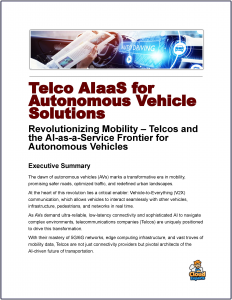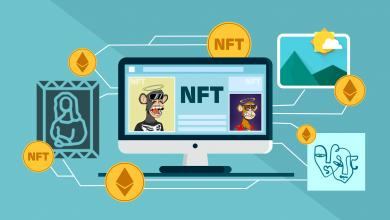 To define revenue strategies for new Telco AI products, particularly by developing an AI platform extensible as an “As a Service” (AIaaS) model for use cases like Autonomous Vehicles (AVs), Telcos can capitalize on their unique infrastructure, data, and connectivity strengths.
To define revenue strategies for new Telco AI products, particularly by developing an AI platform extensible as an “As a Service” (AIaaS) model for use cases like Autonomous Vehicles (AVs), Telcos can capitalize on their unique infrastructure, data, and connectivity strengths.
Telcos are well-positioned to create a modular, scalable AI platform that leverages their control over high-speed 5G/6G networks, edge computing capabilities, and vast datasets from mobile users.
Such a platform would enable real-time, low-latency applications critical for AVs, while also serving other industries like healthcare or logistics.
The platform’s architecture should integrate edge AI infrastructure for local data processing, 5G/6G connectivity for ultra-reliable communication, and a data management layer to harness anonymized Telco data for model training.
Additionally, a marketplace for pre-built and third-party AI models, robust security measures, and standardized APIs/SDKs would ensure flexibility and ease of integration. By designing the platform with microservices and containerization, Telcos can offer white-labeled, scalable solutions that customers can tailor to specific needs, making it ideal for an AIaaS delivery model.
For Autonomous Vehicles, the platform must address stringent requirements like real-time decision-making, high-bandwidth connectivity, and advanced AI for perception, planning, and control.
Telcos can deliver value through targeted AIaaS offerings tailored to AV needs. For instance, edge-based computer vision models can process LiDAR, radar, and camera data for object detection and 3D mapping with minimal latency, enabled by 5G and Multi-Access Edge Computing (MEC).
Similarly, AI-driven network orchestration can facilitate vehicle-to-everything (V2X) communication, ensuring seamless interaction between vehicles, infrastructure, and pedestrians through dedicated network slices. Predictive maintenance models, leveraging IoT data from connected vehicles, can help fleet operators reduce downtime, while dynamic route optimization algorithms, informed by real-time traffic and network data, can improve efficiency.
Passenger experience services, such as personalized entertainment or advertising, can also be powered by AI recommendation engines, drawing on anonymized subscriber data. To meet AV technical demands, the platform must deliver sub-10ms latency, high-definition video streaming, 99.999% network reliability, and scalable processing for millions of vehicles, all while using federated learning to protect data privacy.
Revenue strategies for the AIaaS platform should focus on diverse pricing models and strategic partnerships to capture value from AV stakeholders like OEMs, fleet operators, and smart cities. Subscription-based plans can offer tiered access to services like API calls or compute hours, while pay-per-use pricing can charge based on data processed or vehicles connected.
Revenue-sharing agreements with AV operators can monetize passenger services like in-vehicle ads, and a freemium model can attract developers with basic services while upselling premium features like V2X or high-definition mapping. Outcome-based pricing, tied to benefits like fuel savings or accident reduction, can align with customer value.
Partnerships are equally critical: co-developing AI models with AV manufacturers, optimizing fleets for operators, integrating with smart city traffic systems, or fostering a developer ecosystem through SDKs can drive adoption and scale. Telcos can further boost revenue by bundling AIaaS with 5G or IoT plans, upselling advanced analytics, and leveraging existing infrastructure to minimize costs. Collaborations with cloud providers can enable cost-effective hybrid cloud-edge deployments.
Despite the opportunities, Telcos face challenges in executing this vision. Competition from hyperscalers like AWS or Google, with their mature AI platforms, requires Telcos to differentiate through 5G, edge computing, and mobility data advantages. Regulatory compliance, particularly for AV safety and data privacy, demands built-in adherence to standards like ISO 26262 and GDPR, as well as proactive engagement with regulators.
Customer adoption may be slow due to hesitation from AV operators, which can be mitigated through pilots, proof-of-concepts, and freemium tiers to demonstrate value. Integrating with diverse AV systems adds technical complexity, but standardized APIs and dedicated support can simplify onboarding.
To illustrate potential, consider a Telco targeting 10,000 AVs in a major city by 2027, achieving 20% market share with a $1,000/month per-vehicle bundle for V2X, perception, and routing services. This could generate $24 million annually, with an additional $6 million from upselling predictive maintenance, totaling $30 million in direct revenue, plus further gains from partnerships and data services.
In conclusion, Telcos can build a powerful AIaaS platform for AVs by harnessing their network, edge, and data assets to deliver real-time, secure, and scalable AI services. By addressing AV-specific needs like perception, V2X, and route optimization, and adopting flexible pricing models like subscriptions, pay-per-use, and outcome-based fees, Telcos can unlock significant revenue streams. Strategic partnerships with OEMs, fleet operators, and smart cities will amplify impact, while overcoming challenges like competition and regulation will ensure success.
This positions Telcos as pivotal enablers in the AV ecosystem, with the potential to expand the platform to other verticals for even greater value creation. If desired, I can explore a specific use case in depth, analyze a Telco’s capabilities, or visualize a revenue model breakdown.
Introduction: Revolutionizing Mobility – Telcos and the AI-as-a-Service Frontier for Autonomous Vehicles
The dawn of autonomous vehicles (AVs) marks a transformative era in mobility, promising safer roads, optimized traffic, and redefined urban landscapes.
At the heart of this revolution lies a critical enabler: Vehicle-to-Everything (V2X) communication, which allows vehicles to interact seamlessly with other vehicles, infrastructure, pedestrians, and networks in real time. As AVs demand ultra-reliable, low-latency connectivity and sophisticated AI to navigate complex environments, telecommunications companies (Telcos) are uniquely positioned to drive this transformation.
With their mastery of 5G/6G networks, edge computing infrastructure, and vast troves of mobility data, Telcos are not just connectivity providers but pivotal architects of the AI-driven future of transportation.This book explores how Telcos can harness their technological strengths to build AI-as-a-Service (AIaaS) platforms tailored for V2X, unlocking new revenue streams while powering the autonomous vehicle ecosystem.
By integrating 5G’s ultra-reliable low-latency communication, Multi-Access Edge Computing (MEC), and AI models for real-time decision-making, Telcos can deliver critical services like collision avoidance, dynamic routing, and cooperative perception.
These platforms, designed for scalability and interoperability, extend beyond AVs to support smart cities, logistics, and beyond, creating a versatile foundation for innovation. Yet, the path is not without challenges—competition from hyperscalers, regulatory complexities, and integration hurdles demand strategic foresight.
Through a blend of technical insights, case studies, and strategic frameworks, this book outlines how Telcos can implement V2X within AIaaS platforms, addressing AV-specific needs while crafting sustainable revenue models. From subscription-based pricing to strategic partnerships with AV manufacturers and municipalities, we delve into practical approaches to monetize these platforms.
Whether you’re a Telco executive, an AV developer, or a policymaker shaping the future of mobility, this book offers a roadmap to navigate the convergence of AI, connectivity, and autonomous transportation, illuminating the role of Telcos as catalysts in this new era of intelligent mobility.
